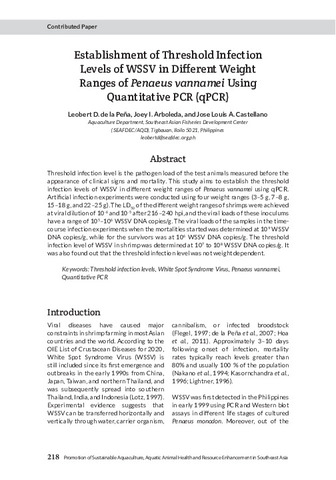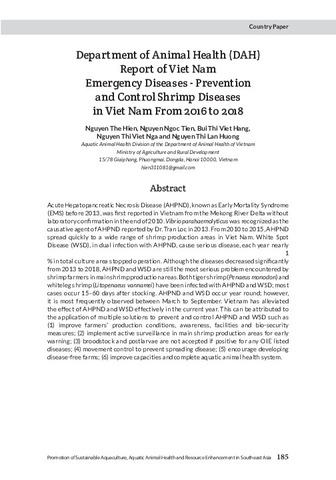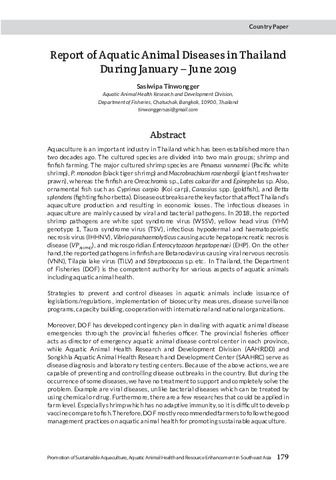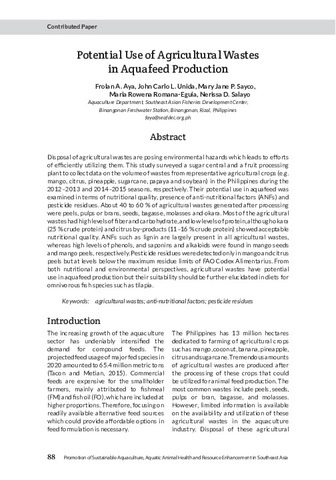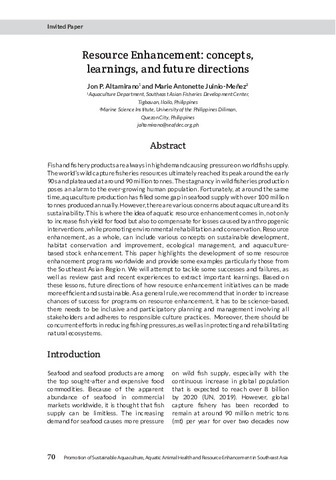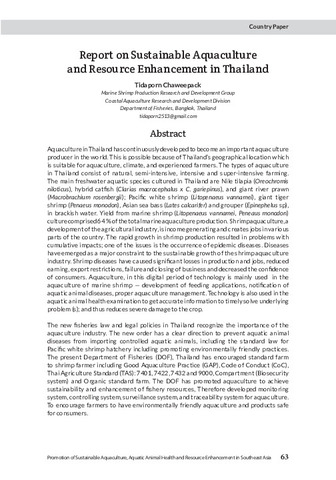Promotion of Sustainable Aquaculture, Aquatic Animal Health, and Resource Enhancement in Southeast Asia (SARSEA)
Browse by
Proceedings of the International Workshop on the Promotion of Sustainable Aquaculture, Aquatic Animal Health, and Resource Enhancement in Southeast Asia 25–27 June 2019, Iloilo City, Philippines
In order to promote and augment regional initiatives on sustainable aquaculture, aquatic animal health and resource enhancement, and to consequently contribute to poverty alleviation, livelihood and food security, the Southeast Asian Fisheries Development Center/Aquaculture Department (SEAFDEC/AQD) has held a 3-day workshop on the “Promotion of Sustainable Aquaculture, Aquatic Animal Health and Resource Enhancement in Southeast Asia (SARSEA)” on 25–27 June 2019 in Iloilo City, Philippines.
The workshop discussed the issues related to sustainable aquaculture, aquatic animal health and resource enhancement, through “Country reports,” from SEAFDEC member countries, “AQD GOJ-TF6 Research Reports,” which were being carried out under the Government of Japan Trust Fund 6 from 2015 to 2019, and were presented by the AQD researchers, “Special Presentations” from the Invited Resource Speakers,” and “Workshop Discussion” for identification of research gaps and collaborative activities among member countries.
This publication is a product of the workshop and compiles information from the thirty presentations made during the event. Reports from member countries, invited experts, and SEAFDEC/AQD projects supported by the GOJ-TF on the topics of sustainable aquaculture, resource enhancement, and aquatic animal health are bared in these pages. The workshop summary, synthesizing the key points raised during the workshop, should be a valuable reference on the broad challenges we face, as well as the solutions and actions that must be done.
Excerpt from Foreword by Dan D. Baliao
Chief, SEAFDEC/AQD
Copyright

This work is licensed under a Creative Commons Attribution-NonCommercial-ShareAlike 3.0 IGO License.
This license requires that reusers of the material give credit to the licensor, the Aquaculture Department of the Southeast Asian Fisheries Development Center. Reusers may distribute, remix, adapt, and build upon the material in any medium or format, for noncommercial purposes only and not in any way that suggests the licensor endorses the reuser. If others modify or adapt the material, they must license the modified material under identical terms.
Contents
- Foreword
- Messages
- Workshop Overview
- Acknowledgement
-
I. Sustainable Aquaculture and Resource Enhancement
-
A. Country Papers
-
Current Status of Sustainable Aquaculture and Resource Enhancement in Cambodia
Ros Kunthy -
Sustainable Aquaculture Development in Indonesia
Rizna A. Wardhana, Erna Yuniarsih, and Irham Adhitya -
Sustainable Aquaculture and Resource Enhancement in Lao PDR
Khamhou Thongsamouth -
Promotion of Sustainable Aquaculture in Malaysia
Azimah Jumatli and Mohamad Saupi Ismail -
Sustainable Aquaculture and Resource Enhancement in Myanmar
Ohnmar Aung -
Trends in the Major Aquaculture Food Fish Production in the Philippines
Roy C. Ortega -
Report on Sustainable Aquaculture and Resource Enhancement in Thailand
Tidaporn Chaweepack
-
Current Status of Sustainable Aquaculture and Resource Enhancement in Cambodia
-
B. Invited Papers
-
Problems and Challenges of Aquaculture in Japan
Satoshi Watanabe and Tomoko Sakami -
Resource Enhancement: concepts, learnings, and future directions
Jon Altamirano and Marie Antonette Juinio-Meñez
-
Problems and Challenges of Aquaculture in Japan
-
C. Contributed Papers
-
Potential Use of Agricultural Wastes in Aquafeed Production
Frolan A. Aya, John Carlo L. Unida, Mary Jane P. Sayco, Maria Rowena Romana-Eguia, and Nerissa D. Salayo -
Ammonia, Phosphate, Total Suspended Solid and Chlorophyll a Removal in Mangrove Habitat Receiving Shrimp Pond Effluents
Eleonor A. Tendencia and Geraldine C. Quitor -
Integrated Production of Abalone, Haliotis asinina, and Sandfish, Holothuria scabra, Through Community-Based Resource Enhancement (CBRE) in Molocaboc Island in Sagay Marine Reserve, Philippines
Nerissa D. Salayo, Jon P. Altamirano, Quenie S. Montinola, Raisa Joy G. Castel, Rafael T. Barrido, Dianne Hope M. Tormon-West, Roselyn N. Baylon, Nelbert G. Pacardo, and Margarita T. Arnaiz -
Promotion of Resource Enhancement of Seahorse in an Island Community in Negros Occidental, Central Philippines
Shelah Mae B. Ursua -
Training Updates on Marine Fish Hatchery
Rosenio R. Pagador
-
Potential Use of Agricultural Wastes in Aquafeed Production
-
A. Country Papers
-
II. Aquatic Animal Health
-
A. Country Papers
-
The Status of Aquatic Animal Health in Cambodia
Virakbot Hou, Chan Dara Khan, and Somony Thay -
Status of Aquatic Animal Health in Indonesia
Yan Evan and Niezha Eka Putri -
Report on Aquatic Animal Health in Lao PDR
Souksakhone Chanthalaphone -
Country Report on Aquatic Animal Health in Malaysia
Sufian Mustafa, Nik Haiha Nik Yusoff, Beng Chu Kua, Azila Abdullah, and Rimatulhana Ramly -
Aquatic Animal Health in Myanmar
Thidar Aye -
Status of Aquatic Animal Health in the Philippines
Joselito R. Somga, Sonia S. Somga, Jeryl Belle C. Rafanan, Joseph Adrian G. Loja, Ethel Ann E.Yap, Ma Eliza Ann E. Mayor, Irish Marie D. Alvaran, and Cindy M. De La Cruz -
Country Report - Singapore
Bing Liang and He Sheng Neo -
Report of Aquatic Animal Diseases in Thailand during January – June 2019
Sasiwipa Tinwongger -
Department of Animal Health (DAH) Report of Emergency Diseases - Prevention and Control of Shrimp Diseases in from 2016 to 2018
Nguyen The Hien, Nguyen Ngoc Tien, Bui Thi Viet Hang, Nguyen Thi Viet Nga, and Nguyen Thi Lan Huong
-
The Status of Aquatic Animal Health in Cambodia
-
B. Invited Papers
-
Acute Hepatopancreatic Necrosis Disease (AHPND) and Hepatopancreatic Microsporidiosis (HPM): two threats to sustainable shrimp aquaculture
Arun K. Dhar and Hung N. Mai -
Research Update on Emergent Shrimp Pathogens in Thailand
Kallaya Sritunyalucksana
-
Acute Hepatopancreatic Necrosis Disease (AHPND) and Hepatopancreatic Microsporidiosis (HPM): two threats to sustainable shrimp aquaculture
-
C. Contributed Papers
-
Establishment of Threshold Infection Levels of WSSV in Different Weight Ranges of Penaeus vannamei Using Quantitative PCR (qPCR)
Leobert D. de la Peña, Joey I. Arboleda, and Jose Louis A. Castellano -
Efficacy of the Inactivated Nervous Necrosis Virus Vaccine Against Viral Nervous Necrosis in Pond-Reared Orange-Spotted Grouper Epinephelus coioides
Rolando Pakingking Jr., Evelyn Grace de Jesus-Ayson, and Cleresa Dionela -
Application of Carriers and RNAi to Enhance the Antiviral Immune Response of Shrimp to WSSV
Edgar Amar, Charis Baes, Joshua Superio, Mechil Somera, and Christian Cordero -
Acute Toxicity of Garlic (Allium sativum) Extract to Snubnose Pompano (Trachinotus blochii) Juvenile
Gregoria Erazo-Pagador -
Factors Affecting Mortality of Shrimp, Penaeus monodon, Experimentally Infected with Vibrio parahaemolyticus Causing Acute Hepatopancreatic Necrosis Disease (VPAHPND)
Eleonor Tendencia and Geraldine Quitor
-
Establishment of Threshold Infection Levels of WSSV in Different Weight Ranges of Penaeus vannamei Using Quantitative PCR (qPCR)
-
A. Country Papers
- Summary of Workshop Discussion
- Directory of Participants
Recent Submissions
-
Establishment of threshold infection levels of WSSV in different weight ranges of Penaeus vannamei using quantitative PCR (qPCR)
(Aquaculture Department, Southeast Asian Fisheries Development Center, 2021-12)Threshold infection level is the pathogen load of the test animals measured before the appearance of clinical signs and mortality. This study aims to establish the threshold infection levels of WSSV in different weight ... -
Research update on emergent shrimp pathogens in Thailand
(Aquaculture Department, Southeast Asian Fisheries Development Center, 2021-12)Recent evidence suggest that the emergent microsporidian, Enterocytozoon hepatopenaei (EHP) is a component cause of white feces syndrome (WFS) in shrimp. The natural WFS shrimp were found to be infected with EHP. At the ... -
Acute hepatopancreatic necrosis disease (AHPND)) and hepatopancreatic microsporidiosis (HPM):): Two threats to sustainable shrimp aquaculture
(Aquaculture Department, Southeast Asian Fisheries Development Center, 2021-12)Infectious diseases caused by viruses and bacteria are a major threat to sustainable shrimp farming globally. Since early 80’s viral diseases such as White Spot Disease, Taura Syndrome disease have caused enormous losses ... -
Department of Animal Health (DAH) report of emergency diseases - prevention and control of shrimp diseases in from 2016 to 2018
(Aquaculture Department, Southeast Asian Fisheries Development Center, 2021-12)Acute Hepatopancreatic Necrosis Disease (AHPND), known as Early Mortality Syndrome (EMS) before 2013, was first reported in Vietnam from the Mekong River Delta without laboratory confirmation in the end of 2010. Vibrio ... -
Report of aquatic animal diseases in Thailand during January – June 2019
(Aquaculture Department, Southeast Asian Fisheries Development Center, 2021-12)Aquaculture is an important industry in Thailand which has been established more than two decades ago. The cultured species are divided into two main groups; shrimp and finfish farming. The major cultured shrimp species ... -
Country report - Singapore
(Aquaculture Department, Southeast Asian Fisheries Development Center, 2021-12)The aquaculture industry produces about 10 % of Singapore’s annual local fish consumption. By 2030, the country’s goal is for the agri-food industry to produce 30 % of Singapore’s nutritional needs. In order to achieve ... -
Status of aquatic animal health in the Philippines
(Aquaculture Department, Southeast Asian Fisheries Development Center, 2021-12)The national aquatic animal disease surveillance and reporting system is implemented by the Bureau of Fisheries and Aquatic Resources in coordination with other recognized laboratories. It covers the OIE/NACA listed diseases ... -
Aquatic animal health in Myanmar
(Aquaculture Department, Southeast Asian Fisheries Development Center, 2021-12)In 2010, several viruses infected Penaeus monodon in the ponds of Myanmar. This includes the White Spot Syndrome Virus (WSSV) which causes the White Spot Disease (WSD). In addition, Taura Syndrome Virus (TSV) and Infectious ... -
Country report aquatic animal health in Malaysia
(Aquaculture Department, Southeast Asian Fisheries Development Center, 2021-12)The fisheries sector of Malaysia plays a significant role in economic development. It provides employment, foreign exchange and protein supply for the country. In 2017, aquaculture production in Malaysia was 427,022 tonnes, ... -
Report on aquatic animal health in Lao PDR
(Aquaculture Department, Southeast Asian Fisheries Development Center, 2021-12)Fish production is very important to Lao PDR. It is an important source of protein to its citizens. Lao PDR is fortunate to have numerous water resources. The Mekong River flows through Lao PDR for a length of 1,865 km. ... -
Status of aquatic animal health in Indonesia
(Aquaculture Department, Southeast Asian Fisheries Development Center, 2021-12)Fish disease is one of the main obstacles in the success of aquaculture production because of the loss caused by it. The outbreak of diseases has resulted to a substantial economic loss which was reported to have reached ... -
The status of aquatic animal health in Cambodia
(Aquaculture Department, Southeast Asian Fisheries Development Center, 2021-12)Human population in Cambodia keeps increasing from year to year and the demand for food consumption also increases. Food products in Cambodia come from two main sources: terrestrial and aquatic. In this sense, aquaculture ... -
Training updates on marine fish hatchery
(Aquaculture Department, Southeast Asian Fisheries Development Center, 2021-12)One of the major constraints confronting the sustainable development of the aquaculture industry in the world, particularly in Southeast Asia, is the availability of quality fish seeds for stocking in ponds and cages. With ... -
Promotion of resource enhancement of seahorse in an island community in Negros Occidental, Central Philippines
(Aquaculture Department, Southeast Asian Fisheries Development Center, 2021-12)To promote the protection and sustainability of seahorses for their conservation, efforts have been done through stock enhancement by releasing captive-bred seahorses. However, preparatory activities are necessary for the ... -
Integrated production of abalone, Haliotis asinina, and sandfish, Holothuria scabra, through Community-Based Resource Enhancement (CBRE) in Molocaboc Island in Sagay Marine Reserve, Philippines
(Aquaculture Department, Southeast Asian Fisheries Development Center, 2021-12)This study conducted participatory enhancement of abalone Haliotis asinina and sandfish Holothuria scabra stocks using hatchery-bred and reared seeds released in the shores of Molocaboc Island in multi-use buffer zone of ... -
Ammonia, phosphate, total suspended solid and chlorophyll a removal in mangrove habitat receiving shrimp pond effluents
(Aquaculture Department, Southeast Asian Fisheries Development Center, 2021-12)Diseases continue to devastate the shrimp industry. One culture system that has the potential to abate disease occurrence, improve shrimp survival and environmentfriendly is aquasilviculture. Aquasilviculture is the culture ... -
Potential use of agricultural wastes in aquafeed production
(Aquaculture Department, Southeast Asian Fisheries Development Center, 2021-12)Disposal of agricultural wastes are posing environmental hazards which leads to efforts of efficiently utilizing them. This study surveyed a sugar central and a fruit processing plant to collect data on the volume of wastes ... -
Resource enhancement: Concepts, learnings, and future directions
(Aquaculture Department, Southeast Asian Fisheries Development Center, 2021-12)Fish and fishery products are always in high demand causing pressure on world fish supply. The world’s wild capture fisheries resources ultimately reached its peak around the early 90s and plateaued at around 90 million ... -
Problems and challenges of aquaculture in Japan
(Aquaculture Department, Southeast Asian Fisheries Development Center, 2021-12)This paper describes the present status of aquaculture in Japan. The production volumes of many of the wide variety of aquatic organisms cultured in Japan, including finfishes, bivalves, crustaceans and seaweeds, are on a ... -
Report on sustainable aquaculture and resource enhancement in Thailand
(Aquaculture Department, Southeast Asian Fisheries Development Center, 2021-12)Aquaculture in Thailand has continuously developed to become an important aquaculture producer in the world. This is possible because of Thailand’s geographical location which is suitable for aquaculture, climate, and ...

